
The issue of the Zefira newspaper from July 5, 1904 - announcing the death of Benjamin Ze'ev Herzl. A large title in a black mournful frame: "Herzl passed away!". "Special siren telegram" - two days after his death on June 3, before the burial arrangements were known.
The newspaper announces that: "Vienna at 12:00 noon, Dr. Hirtzel died, "by the day of the burial we will inform", and a long obituary appears: "We were orphans! The great heart, the heart of the lion and the eagle... stopped beating... not only all of us Zionists, But all of us, the members of the Hebrew nation, were hit. This is a calamity that will not be resolved... Never was a wise and mighty man like him... the dead is laid before us - and we will weep, oh we will weep, we will weep...". On the second page is a large image of Herzl as he was photographed on the balcony of his room at the "Three Kings" hotel in Basel, in the days when the First Zionist Congress was held.
[4] pages. A complete sheet. 49 cm. Stains. Fold mark. Good condition.

A special memorial issue of the "HaIvri" newspaper - in memory of Theodor Herzl - July 21, 1916 - twelve years since his death. The entire issue deals with Herzl - rare articles and photographs.
On the title page is a picture of Herzl and a poem about Herzl by Israel Efrat. The editorial deals with the wonderful phenomenon of Herzl having more fans in his death than in his life, and states that the foundation of the Zionist Federation is the association around the figure of Herzl. There is an interesting article by Dr. Korelnik in which he describes Herzl's practical approach when on one occasion he made it clear to him that: "Our generation is a generation of actions and not of ophistry", and therefore advised him not to publish in his newspaper Montefiore's commentary on ancient Judaism. There is also Important article about Herzl by Rabbi Y. L. HaCohen Fishman - "Herzl and the Mizrachi" which describes how Herzl stated that Zionism would not do anything that goes against the religion of Israel, and describes Herzl's attitude to the Mizrachi movement and religion, etc. The issue is accompanied by, a photograph from Herzl's funeral, Herzl's grave in Vienna, and more.
15 p. Very good condition.

דער אידנשטאט א פארזוך פאר א מאדערנער ליזונג פון דער אידנפרראגע - Theodore Herzl - The Jewish State - Yiddish edition translated by A. L. Schussheim. Buenos Aires, 1948, with introduction by Chaim Weizmann, published by the South American Office of the Jewish Agency.
This edition includes an autobiography about Herzl, and a long introduction by Chaim Weizmann about the historical importance of the book "The Jewish State" to the Zionist movement, about the prophetic spirit in which it was written, and about the spirit it breathed into many of the younger generation of the Zionist movement since its publication.
In 'The Jewish State' [Der Judenstaat] Herzl outlines his vision for the future Jewish state in great detail. Herzl outlined the structure of the future state, in days when it was considered a distant dream by most Jews. The book was first published in Vienna and Leipzig by M. Breitenstein in February 14, 1896, under the subtitle: "An Attempt at a Modern Solution to the Jewish Question", a year and a half before the convening of the First Zionist Congress. About the writing method of the book, Herzl wrote: "I do not remember writing anything in my life in such a state of exaltation as when I wrote this book...In writing this book, I worked on it day after day until all my strength ran out". None of the reputable publishers wanted to publish the book, including Herzl's regular publishers Dunkner and Humboldt from Leipzig. Also the Cronbach House in Berlin, which was Jewish owned, refused to publish it. Ultimately Herzl published it with Max Breitenstein, an assimilated Jew and owner of a small bookstore in Vienna. Breitenstein himself did not believe in the Zionist idea as a whole, nor in the commercial success of the book, and agreed to publish it based on his personal acquaintance with Herzl's close family circle. Upon publication most public figures scorned the ideas presented in it, and one Jewish newspaper editor even offered his carriage to take Herzl to the insane asylum. Despite this, the ideas brought in the book began to gain momentum and additional editions - in Yiddish, Russian, English and more - appeared soon after the German edition, and within a short time it became the foundational book of the Zionist movement's initiators.
139 [1] p. Reinforced spine with adhesive paper. Minor tears on the edges of the front cover. Good condition.

The Story of the ANZACS: An Historical Account of the Part Taken by Australian and New Zealand in the Great War from the Outbreak in August 1914 until the Evacuation of Gallipoli in December 1915, published by "James Ingram & Son The Block", Melbourne (Australia), 1917 - First Edition.
The heroic story of the Australian and New Zealand Army Corps (or ANZAC) which fought in World War I alongside the Allies against the Central Powers at Gallipoli, in the Middle East and on the Western Front. A detailed description of the military buildup for battle and the battles themselves at Gallipoli and its surroundings, the organization of the Australian and New Zealand units in Egypt after the evacuation of Gallipoli in 1915, and the heroic story of the men of the Australian Imperial Force - the Fourth and Fifth Divisions.
At the beginning of the book is a handwritten list of names of Australian soldiers who fell in battle.
[5], 153 p. + [7] plates of photographs and [5] plates of maps. 26 cm. Minor stains. Used cover. Good condition.

Issue of the French Le Petit Journal dated March 4, 1917 - A large photo on the title page of Baron Birdwood Field Marshal in the British Army - Commander of the Australian and New Zealand forces - "ANZAC" during the Battle of Gallipoli, and commander of the Fifth Army during the war on the Western Front.
At the opening of the issue dedicated to Birdwood is written: "Sir WILLIAM BIRDWOOD Commander of the Australian and New Zealand Corps. Alongside the portraits of the great leaders of our army, it seems legitimate to us to give our readers also those of the leaders of our Allied armies fighting alongside us for the same goal of justice and liberty. Thus we offer them today with the portrait of Sir William Birdwood, the supreme commander of the Australian and New Zealand Corps".
This young and spirited general commanded these superb forces that excelled in Gallipoli, Egypt and finally on the British front. Like his soldiers, General Birdwood felt sympathy for France. One of our colleagues who lived among General Birdwood's soldiers said recently about the Australian soldier: "Here he is now at the front line, in the trenches. Two years of training prepared and hardened him. He will fight well, he will make an effort, and when returning in all his splendor to his distant shores, we can imagine he will take with him a friendly and lasting memory of his stay in France".
In the center pages of the issue a large map appears - A panoramic view of the war front in Lassigny (France). In the back of the issue are photographs from the war events.
[8] pages. Complete issue. 46 cm. Good - Very good condition.

PALESTINE BRITISH EMPIRE EXHIBITION - Informational booklet for the Eretz Israel - Palestine Pavilion, at the British Empire Exhibition held in Wembley, London, in 1924.
The first part of the booklet contains information for tourists visiting Eretz Israel including photographs of important sites in the country's cities - mainly from Jerusalem, in the second part is a guide to the "Palestine" pavilion at the exhibition including a catalog of items from the exhibition. Introduction by the High Commissioner of Eretz Israel Sir Herbert Samuel. At the end of the booklet is a direction map for the exhibition. The booklet is accompanied by dozens of advertisements from manufacturers in Eretz Israel. On the cover is a colorful illustration of the Palestine pavilion at the exhibition. The Eretz Israel pavilion at the exhibition presented samples from the field of Hebrew creativity in Eretz Israel in all its fields: archaeology (findings discovered in Hebron and surroundings were displayed), public works, the Hebrew industry, art objects from "Bezalel", and more.
The British Empire Exhibition was a colonial exhibition held in Wembley, Middlesex in 1924 and 1925. The exhibition was opened by King George V on April 23, Saint George's Day. 58 countries participated in the exhibition. At that time it was the largest exhibition ever held anywhere in the world with 26 million visitors. Its official purpose was to stimulate trade and strengthen ties between the countries. The three main buildings where the exhibition was held were the Palaces of Industry, Engineering and Arts. (Most of the halls where the exhibition was held were meant to be temporary and demolished after its conclusion, but the Palace of Engineering and the British Government pavilion survived into the 1970s).
118 p. Some pages of the booklet were not cut in print. Very good condition.
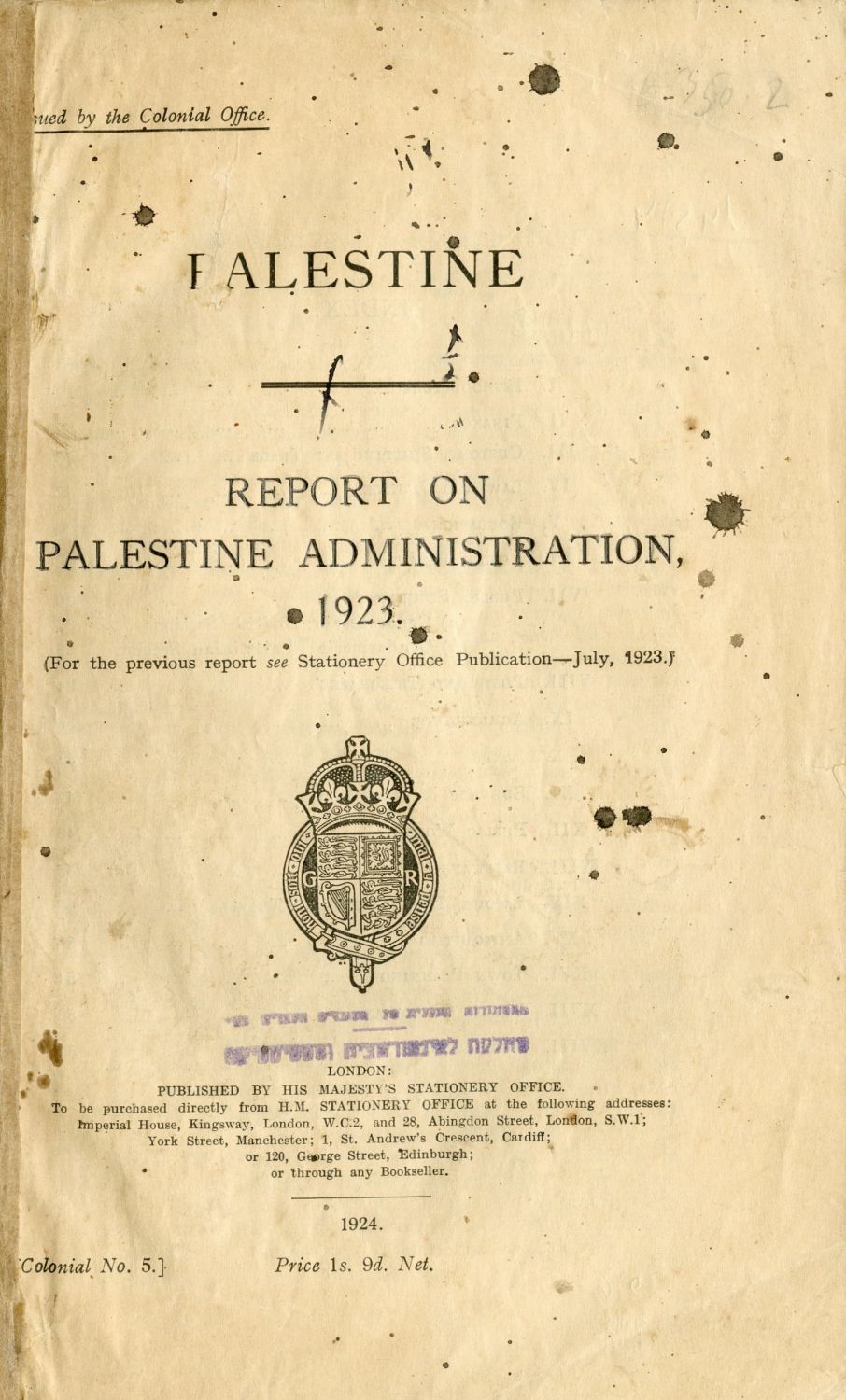
Palestine - Five official reports dealing with the Jewish problem in the Land of Israel, and mandate reports. London and New York 1935 - 1942.
PALESTINE REPORT ON PALESTINE ADMINISTRATION, 1923. London, 1924.
Economic Conditions in PALESTINE REPORT By C. EMPSON British Commercial Agent, Haifa. July 1935.
THE FUTURE OF PALESTINE AN EXAMINATION OF THE PARTITION PLAN BY HERMAN L. WEISMAN. New York 1937.
REPORT by His Majesty's Government in the United Kingdom of Great Britain and Northern Ireland to the Council of the League of Nations on the Administration of for the year 1938, London 1939.
Palestine role in the solution of the Jewish problem by Chaim Weizman, United Palestine Appeal, January 1942.
General condition good.

"The prayer that was prayed in the Congregations of the Sephardic Jews synagogue here in the city of Amsterdam, during the war of the countries of Europe..." Prayer for the success of war "To strike a lethal blow" with the outbreak of World War I. Amsterdam 1914, Hebrew and Dutch page by page.
"רִבּוֹנוֹ שֶׁל עוֹלָם! בְּלֵב נִשְׁבָר וְנִדְכָה אֲלקים לֹא תִבְזֶה נְקַדְמָה פָנֶיךְ לִשְׁפוֹךְ שִׂיחַ לְפָנֶיךְ וּלְבַקֵשׁ מִמְךְ רַחֲמִים: כִּי שָׁמַעְנוּ וַתִּרְגַז בִטְנֵנוּ לְקוֹל צְלְלוּ שְׂפָתֵינוּ קוֹל מִלְחָמָה בְמַחֲנוֹת סְבִיבוֹת אַרְצֵנוּ, קוֹל צְעָקָה בָעִיר וַחֲרָדָה גְדוֹלָה עַד מְאוֹד : מִחוּץ תְּשַׁכֶל חֶרֶב וּמֵחֲדָרִים אֵימָה, גַם בָּחוּר גַם בְּתוּלָה יוֹנֵק עַם אִישׁ שִׂיבָה: שָׁבַת מְשׂוֹשׂ לִבֵּנוּ נֶהְפַךְ לְאֵבֶל מְחוֹלֵנוּ כִי סוֹחֲרִים מִשַׁעַר שָׁבָתוּ בַּחוּרִים מִמְלַאכְתָם וְלֹא נֵדַע מַה... מֶלֶךְ מַלְכֵי הַמְלָכִים בְּרַחֲמֶיךְ הָרַבִּים הֶיֶה נָא מָגֵן וְעֶזֶר לִנְבִרְתֵנוּ הַמַלְכָה יָרוּם הוֹדָה וְשָׁקְטָה וְשָׁאַנְנָה הִיא וְכָל־בֵית הַמַּלְכוּת וְאֵין מַחֲרִיד, גַם בְּלֶב־כָּל־יוֹעֲצֵיהָ תֵן חָכְמָה בִינָה וְדַעַת לַעֲמֹד בַּפֶרֶץ בַּל נִהְיֶה לָבוּז, תֵּן לָהֶם כֹּחַ וּבְרִיאוּת לַעֲמֹד עַל מִשְׁמַרְתָם בֶּן בָּחֶרֶב יֵצְאוּ לִקְרָאתֵנוּ וּפֶן יְעֲבֹר קְרָב בִגְבוּלֵנוּ...".
[4] pages. Minor tears on margins. Good - very good condition.

The Claims of the Arabs and the Answer of the Jews by Meyer Wolfe Weisgal. Published by the Zionist Organization Of America. New York [c. 1930s].
Important publication in which Meyer Wolf responds to Arab claims that Palestine was stolen from them by Jews, explaining the essence of Zionism which in practice concretely expresses the Jewish people's longing to return to their homeland for over two thousand years, and is not a "new" movement, and answers claims seeking to deny the historical connection of the Jewish people to the Land of Israel. Weisgal emphasizes that the historical right of the Jewish people to the Land of Israel does not imply harming the rights of the Arab minority, and that this is anchored in the Balfour Declaration. And proves from Emir Faisal's own words that he recognizes the positive need for the Zionist movement, and more.
Meyer Wolfe Weisgal [1894-1977] was an American Jewish journalist, publisher, playwright, fundraiser, and Zionist activist who served as president of the Weizmann Institute of Science and as founding president of the Museum of the Jewish Diaspora
and also head of the Zionist Organization of America (from 1921 to 1930).
22 p. Very good condition.
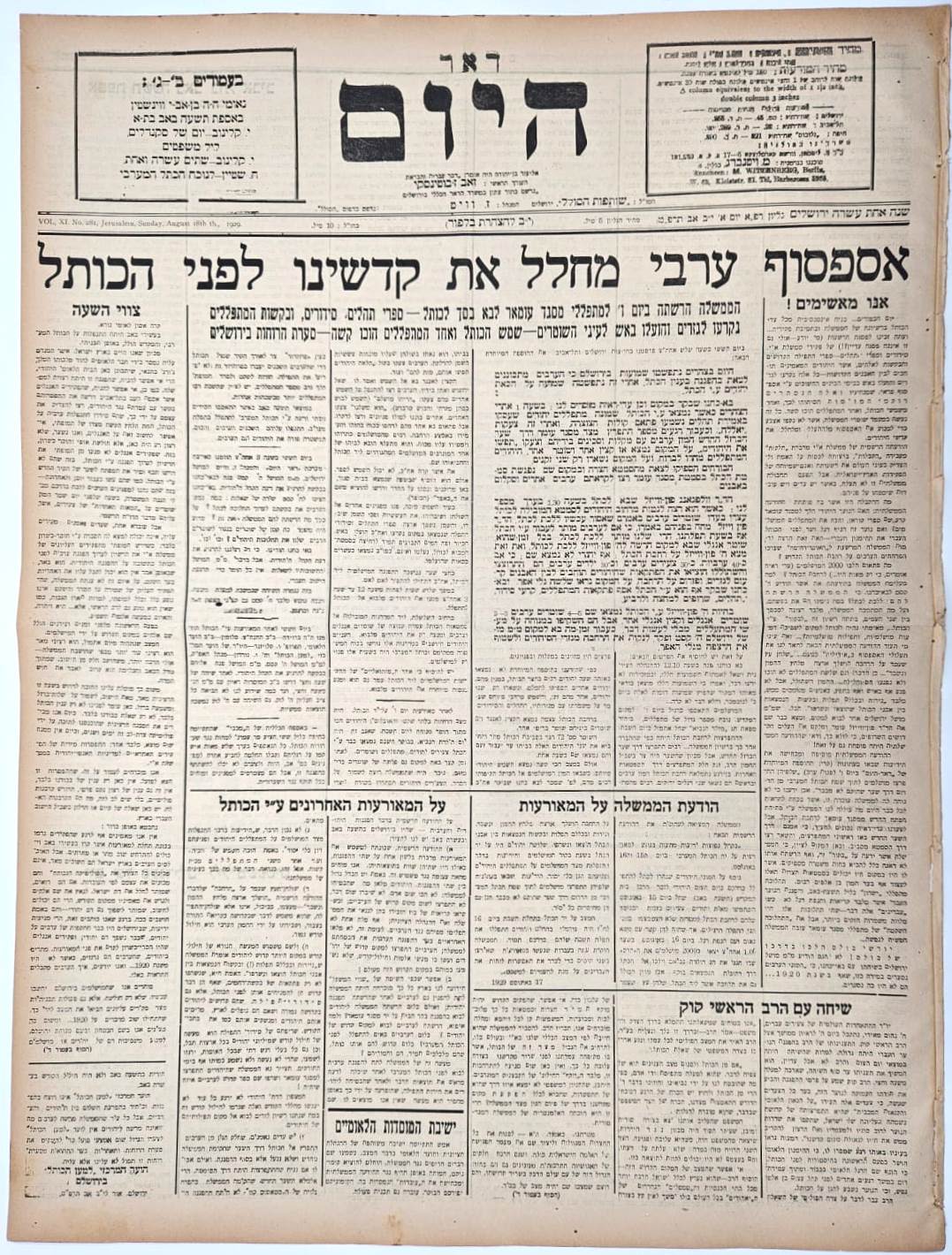
The issue of the newspaper "Doar Hayom" dated August 18, 1929, headlined: "An Arab mob desecrates our sanctuaries in front of the Western Wall" - less than a week before the events of 1929 that broke out - from the early events at the Western Wall that agitated the area before the events broke out, as well as the response of Rabbi Kook to the desecration of the Western Wall.
The magazine reports in the main article that after the (British) government allowed the worshipers of the Omar Mosque to enter the Western Wall, the books of Psalms, siddurs, and prayers of the worshipers (the notes usually placed inside the slots of the Western Wall) were torn to pieces and set on fire in front of the police - The Shamash of the Western Wall and one of the worshipers was severely beaten. Also written that a group of Jews from the Western Wall worshipers were attacked by Arabs.
In fact, as early as September 1928 friction with the Arabs in the Western Wall area, after the first time a partition was put into the Western Wall, the Arabs claimed that there was an attempt by the Jews to take control of the Temple Mount Area, and then the provocations against the Jews began in what is known as the "Wall Affair". After Mufti al-Husseini's announcement in his sermon that it is commanded to harm the Jews in August 1929, the area began to burn, and the issue before us reviews the desecration of the Western Wall that took place a few days before the harm to the jews and the terrible events of 1929.
In the lower part of the title page under the heading "Conversation with the Chief Rabbi Kook", there is an article about a conversation that the chairman of the World Federation of Hebrew Youth, Nahum Meiri, had with Rabbi Kook regarding the events at the Western Wall. In a conversation that lasted over an hour and a half, Rabbi Kook explained how the Western Wall Parsha should be viewed, and the methods of action.
[4] pages. A complete sheet. 61 cm. Slight tears near the edges. Good - very good condition.

Official poster by the British Mandate during the 1929 riots announcing that His Majesty's forces are working to suppress the riots and will not hesitate to use force "against peacebreakers without distinction" / Photo of a Jewish family - three generations of wounded from the Arab 1929 riots.
Poster text: "Announcement: I hereby notify the Palestinian public that His Majesty's forces are acting in this country for the sole purpose of suppressing the current disturbances and restoring order. Exceptional methods of suppression will be avoided as far as possible, but the forces will not hesitate to use force against peacebreakers without distinction. H. C. LUKE Government Administrator. August 25, 1929". This poster was published at the height of the riots the day after the Hebron massacre in which 67 Jews were murdered. It should be noted that the massacre occurred when the British police officer responsible for the Hebron police, Raymond Cafferata, did not lift a finger to stop the murderers and two British mounted policemen watched the massacre without doing anything. Only when the murderers started approaching those same Britons and felt threatened themselves, one of them fired into the air, the murderers fled and the massacre ended. Size: 30x20 cm. Upper left corner restored. Minor tear on the left. Good condition.
Press photo of a family wounded in the Arab riots near Jerusalem described on the back on a piece of paper from the N.E.A. photo agency: "Victims of the Muslim Raid in Palestine Three generations of victims of a Muslim attack on their home on the outskirts of Jerusalem. The father, daughter and granddaughter were injured by the Arab attackers". Dated on the back: September 17, 1929 - about two weeks after the riots subsided. Size: 21x15 cm. Open tear in the lower right corner. Good condition.

The regulations of the Sephardic community in Hebron - Shvat new moon 1937. Printed by typewriter and duplicated by stencil.
Regulations established in Jerusalem for the Sephardic settlement with the aim of restoring it to Hebron After that in the riots of 1929, there were almost no Jews left in Hebron. Among the regulations that appear: "The company's Palterin is temporarily in Jerusalem and will be transferred to Hebron when the Jewish community returns there, the company's goals are: ... to return to the Hebron community refugees who left due to time constraints and provide them all their spiritual and religious needs... to elect a chief rabbi and reorganize the rabbinate and courts of justice ... to preserve the graves of the saints and other holy places in Hebron ... The members: Every Sephardic Jew over the age of 18 who is a resident of Hebron or was a resident of Hebron can be accepted as a member of society ... Once a year a general meeting of the company will convene... ".
In 1927, the Ashkenazi and Sephardic communities were represented on a committee called the "General Committee of the United Hebrew Community in Hebron". The committee was chaired by Rabbi Meir Shmuel Kashmir and Rabbi Yaakov Yosef Slonim. The Av Beit HaDin of the last Sephardic community in Hebron until the riots of 1929 was the saint Rabbi Hanoch Hasson [1867-1929]. In the riots of 1929, Rabbi Hasson and his wife Clara were murdered in their home during the Hebron massacre. Three days after the massacre, the British authorities decided to eliminate the Jewish community in Hebron. The remains of the Jewish community in Hebron were moved to Jerusalem. The houses of the Jews were looted by the rioters. The Hadassah House was converted by the Arabs of Hebron into a girls' school, the Avraham Avinu synagogue was destroyed and a goat shed was built on it. The ancient Jewish cemetery was also desecrated and destroyed. The Jewish settlement in Hebron was renewed for a time in 1930 by 36 Sephardic families numbering about one hundred and sixty people. With the outbreak of the Great Arab Revolt in 1936 (the events of 1936-1939), the last Jews left the city (except for one family). In the specification of the regulations before us, a first attempt was made to return the Sephardic community to the city in the form of regulations for the future, when the Sephardic settlement returned to the city, which actually took place only after its re-occupation in the 1967 Six Day War.
[2] leaves. 33 cm. Light stains. Good condition
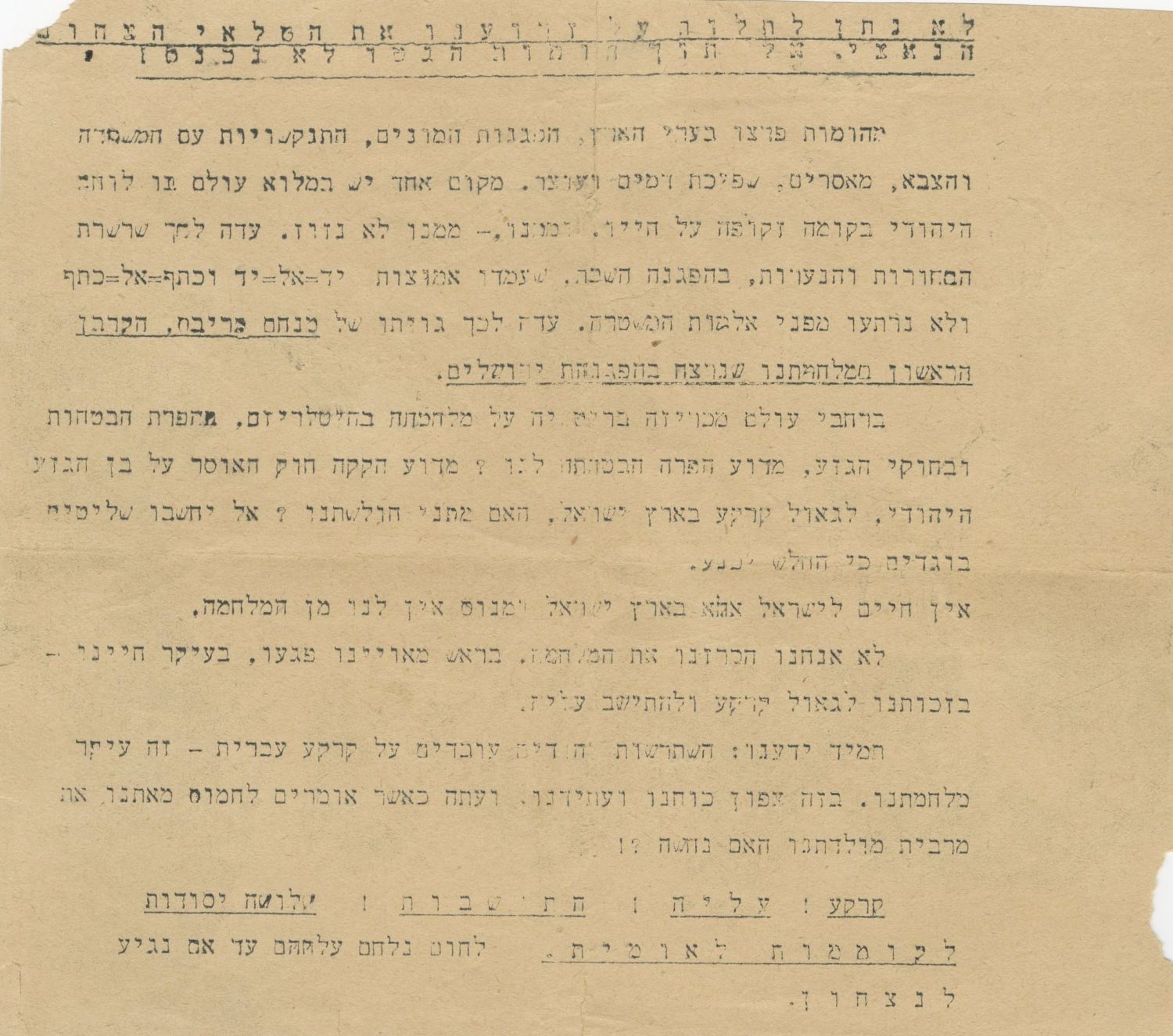
Rare underground flyer against the British Mandate authorities in Eretz Israel following the "Land Transfer Regulations" which limited the sale of land to Jews in Eretz Israel. Eretz Israel, early 1940s.
"We will not let the Nazi yellow badge to hang on our arms, within the ghetto walls we will not enter... Throughout the world Britain declares its war on Hitlerism, in violation of promises and racial laws. Why did it violate its promise to us? Why did it legislate a law forbidding the Jewish race from redeeming land in Eretz Israel... Tyrannical rulers should not think the weak will submit. For Israel there is no life other than in Eretz Israel and from war there is no escape for us... We have always known the settling of Jewish workers on Hebrew land is our main battle. In this lies our might and future. And now, when they say to snatch most of our homeland from us - will we remain silent?! Land! Aliyah! Settlement! Three foundations for national revival. For them we will fight until we attain victory".
The poster was published in 1940 following the publication of the "Land Transfer Regulations" after the publication of the White Paper in 1939 which determined that the sale of land to Jews in Eretz Israel must be limited.
The White Paper published in 1939 determined that the sale of land to Jews in Eretz Israel must be limited. Following the publication of the "White Paper", the "Land Transfer Regulations in Eretz Israel" were published in February 1940 which divided Eretz Israel into three areas: 5% of the territory - an area where land transfers were free (the Sharon and part of the Coastal Plain), an area where land transfers required the approval of the High Commissioner - an area that included about 65% of the Mandate territory, in the Galilee, Samaria, Judea, Gaza and the northern Negev, and 30% of the territory where the sale of land to Jews was prohibited. The Yishuv strongly opposed this decree and the implementation of the regulations was accompanied by protests, demonstrations and a general strike (the demonstrations mentioned in the poster before us). The Land Law remained in effect for the rest of the Mandate period, but the Yishuv did everything it could to oppose it, and continued purchasing lands, most in prohibited areas. With the establishment of the State of Israel, the Law and Administration Ordinance was enacted, regulating the transition from the British Mandate to an independent state with its own laws. One of the important clauses in the ordinance was the annulment of the White Paper decrees (Section 13 of the ordinance) and as part of this clause the Land Transfer Regulations were also annulled retroactively from 18 May 1939.
[1] leaf. 21x19 cm. Minor tears on edges. Good condition.

"Name Change Certificate" - An official certificate to change the family name from Abraham Mordechai Rosenson to "Raziel". Hebrew, Arabic and English. The certificate details that henceforth his name will be "Mordechai Raziel", and also includes the names of his wife Bluma, sons David, Esther and Penina with their new family name of "Raziel". Tel Aviv, March 28, 1928. Official ink stamps of the MAGISTRATE'S COURT in Tel Aviv.
Mordechai Raziel the father of future Knesset member Esther Raziel Naor, and of David Raziel - "Aluf Ben-Anat", one of the founders and fourth commander of the Irgun and Betar commissioner in British Mandate Palestine who was killed in Iraq on a British military mission. Mordechai Raziel immigrated to Eretz Israel in 1914 after receiving an invitation to teach at the "Tachkemoni" school in Tel Aviv. With the outbreak of World War I, the family was deported to Egypt by the Ottomans along with all Jews in the land who were Russian subjects, from there returning to Russia and back to the Eretz Israel in 1923.
43x20 cm. Fold marks. Good condition.

Humorous illustrated story in the form of a long scroll that describes the upheavals of the Jewish settlement in Eretz Israel from the period of World War I until the establishment of the State in 1948. The scroll begins with the title: "Name of the film: Three plagues of Egypt or 'Changes that occurred during 3 wars", and the date: 1948. Watercolors on thick paper.
A long scroll composed of illustrated scenes in color appearing one after the other, accompanied by short humorous descriptions describing the challenges faced by the immigrants to Eretz Israel as the plagues of Egypt, in the harsh conditions of the land - the heat, fleas, bees. Afterwards it describes what is called 'changing apartments' - the development of housing in the land- at first sleeping in the field on the ground (during World War I), later in temporary houses (during World War II), and finally in houses built in the land (during the War of Independence). Afterwards appears a chapter on the change in population - the taking over by the Hebrew Aliyah over the local population - at first immigrants arrived from various countries, later Holocaust survivors with arm bandages, and finally fighters who deny the Arab enemy -"all kinds of Knick-nacks from the neighboring villages to obtain at Gdalke's". The illustrator continues and describes funny scenes from kibbutz life, and at the end the phenomenon of changing the "diaspora" Hebrew names to Israeli names - "attention to a few notices: whoever has not yet changed his name will do so immediately", and planning the new Hebrew construction.
Long scroll, unrolls to 3.5 meters lenth. Height: 11 cm. Seems to have been drawn in one of the kibbutzim. Rare.
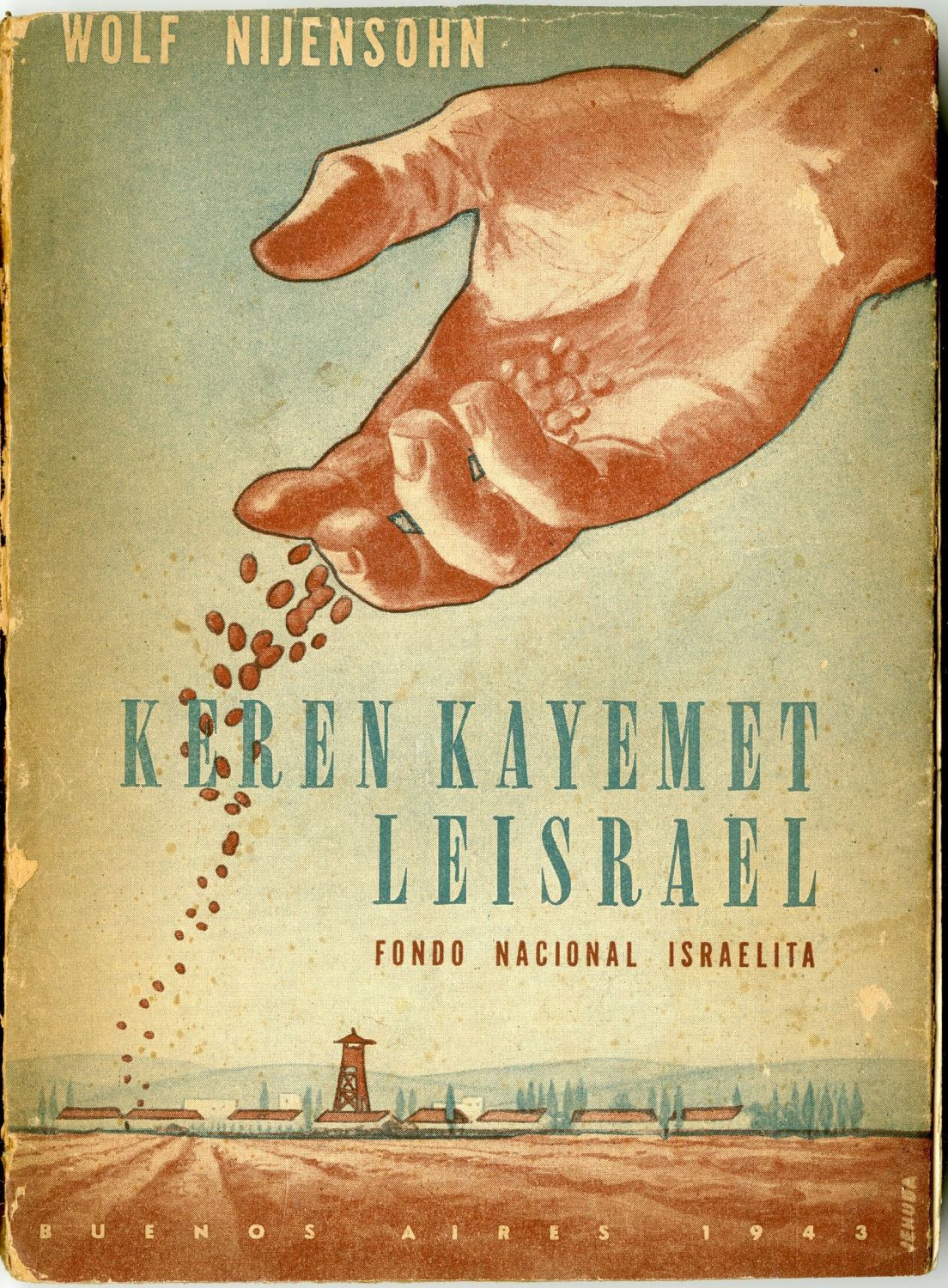
KEREN KAYEMET LEISRAEL FONDS NACIONAL ISRAELITA - The first publication in Spanish in Latin America about Jewish National Fund and its activities, by Dr. Wolf Nijensohn. Buenos Aires, 1943. Cover design: A hand scattering seeds over a Tower and Stockade settlement in Eretz Israel by Leon Poch.
A unique publication about the activities of Jewish National Fund, beginning with the importance of the principle of "redeeming the Land" since the early days of Zionism, when individuals purchased lands in Eretz Israel in order to legally return them to the Jews, and continuing with institutions and organizations that made redeeming the Land of Israel their goal, foremost among them the Jewish National Fund. The author details the work of the first redeemers of the Land since the 19th century - Hermann Schapira, Liliental, and Leon Pinsker, Theodor Herzl's immense activity in fundraising for this enterprise, the establishment of JNF and its work worldwide in the Jewish Diaspora to raise funds for settling Eretz Israel, describing the peak of its success: "There is no country with a Jewish population - no matter how small - that did not donate some amount to KKL, and there is no Jew, whatever his modest economic situation, who cannot afford the pleasure of donating something to its assets". Dr. Wolf describes JNF's various initiatives in addition to land redemption - the worldwide Blue Box enterprise, the Golden Book, the Children's Book, JNF stamp projects, JNF's work in Argentina and more. In the second part, the author deals primarily with numerical data - the amounts and lands acquired by JNF over the years, leasing terms, payment and transfer of ownership to the Fund, and more.
Extremely rare. Does not appear in the world cat library catalog. To the best of our knowledge, it has never appeared at auction.
128 [4] p. Brown paper. Good condition.
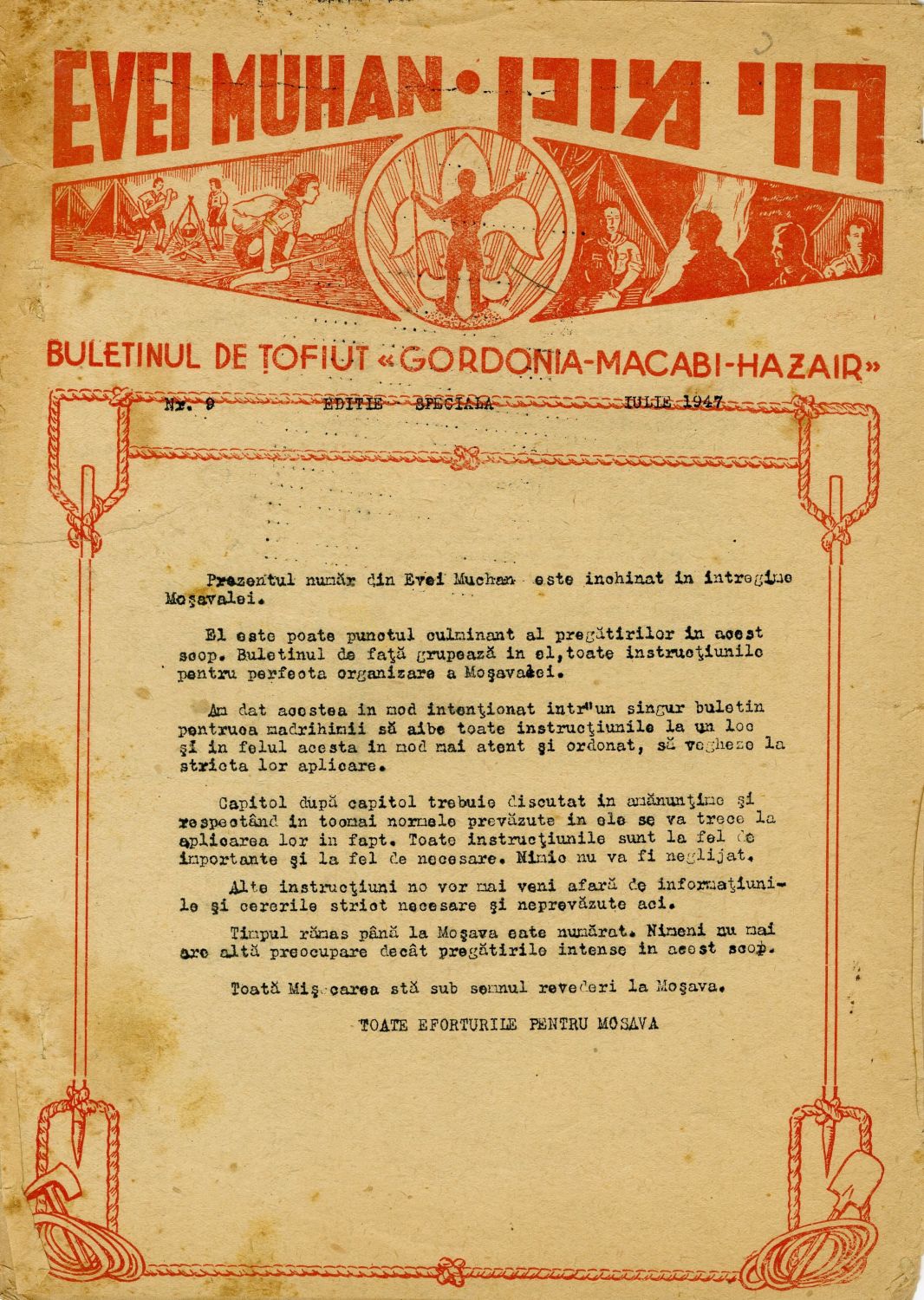
Special issue of the Gordonia youth movement - Maccabi Hatzair - Preparatory bulletin for cultural activities and sports competitions, Stencil printed. Romania, July 1947. Rare.
On the title page is the rare symbol of Maccabi - Gordonia movement, a combination of "Tzofim" movement logo and figure of a person standing facing the rising sun. The bulletin deals with preparing youth, and encouraging skills for various roles in the spirit of the movement, as well as instilling discipline among youths.
19 p. Detached leaves. Minor Stains and tears on margins of title page. Overall good - moderate condition
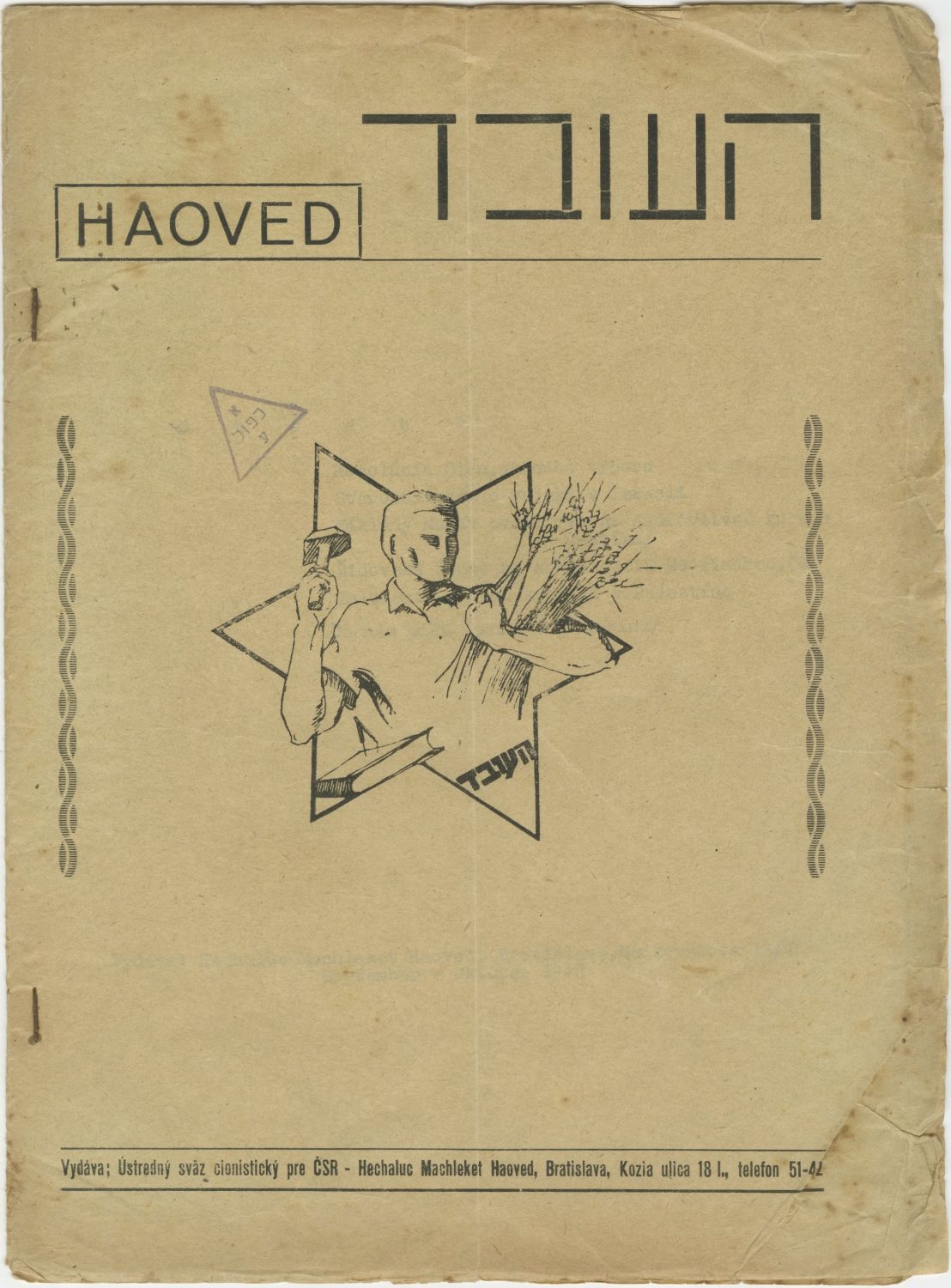
HaOved - The Worker - published by "HaChalutz" - Worker Department in Bratislava, September 1948. Rare stencil printed booklet - the minutes of the Zionist Executive Committee meeting in Bratislava - published by the Central Zionist Association for Czechoslovakia - "Worker" Department - summarizing the decisions of the first meeting held after the establishment of the State of Israel, addressing urgent issues following the declaration of independence.
"The Zionist Action Committee convened at its first meeting in an independent Jewish state declares: With the establishment of the Jewish state, a new era began in the history of the Jewish people. The Zionist organization, which unites all Jews in Israel and the Diaspora, faces the serious and difficult task of organizing free immigration and transforming barren lands into flourishing settlements and deserts into fields and gardens. The Zionist Action Committee proudly acknowledges the rapid rise of the young Jewish state, which has taken root even in the consciousness of the entire world. Israel has become a living reality in the eyes of the Jewish people and the world at large. In this festive moment, the Zionist Action Committee commemorates the founders and fighters of the Zionist movement and reveres with holy awe the founder of the Zionist movement, Dr. T. Herzl. The Zionist Action Committee bows deeply above the graves of six million people who died in the last world war and became victims of the hell of concentration camps. The Zionist Action Committee expresses its deep appreciation for the settlement, its visible attitude, and its admiration for the Israeli army for its victories...".
The booklet deals with urgent matters that arose with the establishment of the State of Israel - the call to arms for all members to defend the state and its institutions. The Zionist Action Committee declared here that every Jew has the basic right to settle in Israel, and it was determined that any prohibition on immigration from any country constitutes an act of hatred against the Jewish people. At the end of the booklet is an article about the establishment of the first settlements in Eretz Israel, etc. Also included is a section referring to Jewish-Arab relations: "This is a historic decree that Jews and Arabs need to live together, and only through friendship and cooperation between Jews and Arabs, as well as other Middle Eastern peoples, can the deserts bloom again, and the Middle East can once again become an economic, cultural, and political force in the lives of nations and the entire world...".
11 p. 30 cm. Minor stains on the cover. Good condition.
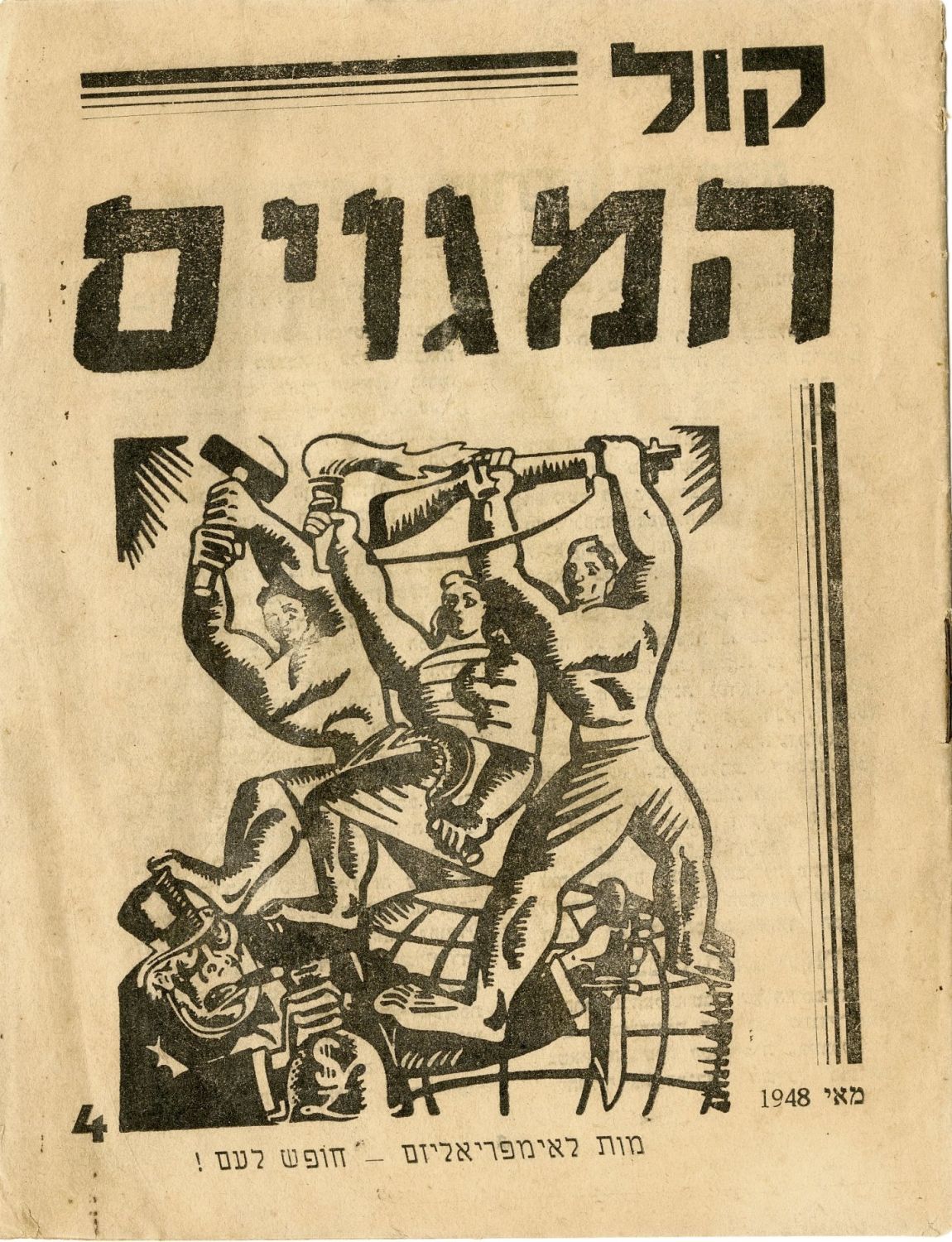
"The blood of our boys spilled in battles with the Arab Legion will fall upon the heads of the hypocritical "neutrals" Bevin and Attlee". The Conscript's Voice - Death to Imperialism - Freedom to the People! - Rare pamphlet of the Communist Youth League in Eretz Israel from the month of the Declaration of Independence, May 1948.
The issue contains articles condemning British and American imperialism and praising the Communist Soviet Union. The main author Meir Vilner, representative of the Communist Party, accuses the British of supporting King Abdullah of Jordan's attacks on Jerusalem "Abdullah's Arab Legion is guided by 40 British officers... Britain finances Abdullah's army with 2 million pounds a year and provides him with all weapons". He also attacks America in this context: "What the British government does more openly, America tries to hide by recognizing Israel "de facto". It must be emphasized: America has not officially recognized the Jewish state. "De facto" recognition alone is not full recognition". He claims America's intention is to replace the British mandate with an Anglo-American mandate. In contrast, it praises the Soviet Union: "Unlike Britain's openly aggressive policy and Truman's two-faced, hypocritical policy - how consistent and encouraging is the policy of the Soviet Union and the people's democracies in Eastern Europe!" It praises the Soviet Union for supporting the establishment of the Jewish state, claiming the USSR more than any other nation stands by the Jewish war of independence. Additional articles spread the ideology of the communist movement in the context of the Declaration of Independence. Includes a photo of Vilner alongside Moshe Sharrett and Ben-Gurion signing the Declaration of Independence.
15 [1] p. 18 cm. Very good condition.

HaBirah. bulletin of Bnei Etzel Jerusalem - Hanukkah Issue, December 1948 - "Internal" - The first publication issued by the organization recently established in Jerusalem. Rare stencil printed booklet covering the pressing issues dealt with upon its establishment - the events of the War of Independence in Jerusalem, and the continuation of Etzel's activity after the Declaration of Independence in the war against the Arab invader, in settlement, and the establishment of the new organization.
An internal booklet of the youth movement "Bnei Etzel" in Jerusalem issued for the Hanukkah holiday. The movement dealt with realizing Etzel's vision after the state's establishment - "Aliyah to the desolate lands of our homeland and preparing them for the settlement of our immigrating brothers" and this is the first booklet it issued. Among others it includes the movement's principles and articles written by movement members on topics like the justice of the War of Liberation and its continuation: "Israel's war will not end until all of Eretz Israel is liberated", the war against the Arab enemy: "Repelling the Arab invader... Any reconciliation with the territories held by the enemy within the borders of the homeland is akin to loss. Our role is to comb through, comb thoroughly our land of the enemy and establish a security belt around it" , the ultimate removal of the British from Eretz Israel, and settlement. It also includes articles on topics like "Hanukkah 1948 in the Exile of Kenya" - a vivid description of how the exiles in Kenya celebrated the Hanukkah holiday, songs of Kenyan exile, "Hanukkah Last Year" - on the Hanukkah holiday amidst the battles of the War of Independence and the defense battles in the Old City of Jerusalem, events in the Old City since the British left on May 13: "The Arabs entered almost every synagogue the Jews of the Old City took shelter in... The blood of the defenders flowed like water in the streets and from time to time a new list of casualties arrived. We no longer paid attention to the lists because we thought that soon we too would go in their path... There were not enough nurses to care for the many wounded and some of them died due to lack of treatment...". Also includes articles on beginning the realization through establishing new settlements, camp life, a jokes column (about Ben-Gurion's visit to the mental hospital in Bat Yam), and more.
The "Bnei Etzel" youth movement in Jerusalem was established in October 1948 by youth from Jerusalem neighborhoods Katamon, Givat Sha'ul, city center and Nahlaot with separate branches for general and religious youth. In addition to pioneering and military activities, the movement had a choir, orchestra, and even a soccer team. It also assisted the needy, provided jobs for immigrants, and training courses.
It should be noted that the Etzel organization itself, from which "Bnei Etzel" sought inspiration for their new organization, was also established in Jerusalem in 1931 when a large group from the Jerusalem branch of the "Haganah" organization (led by Avraham ("Gideon") Tehommy, who was branch commander until shortly before the split), demanded forceful action against the Arab aggression of those days, broke from the "Haganah" and established Etzel.
40 p. 20 cm. Very good condition.
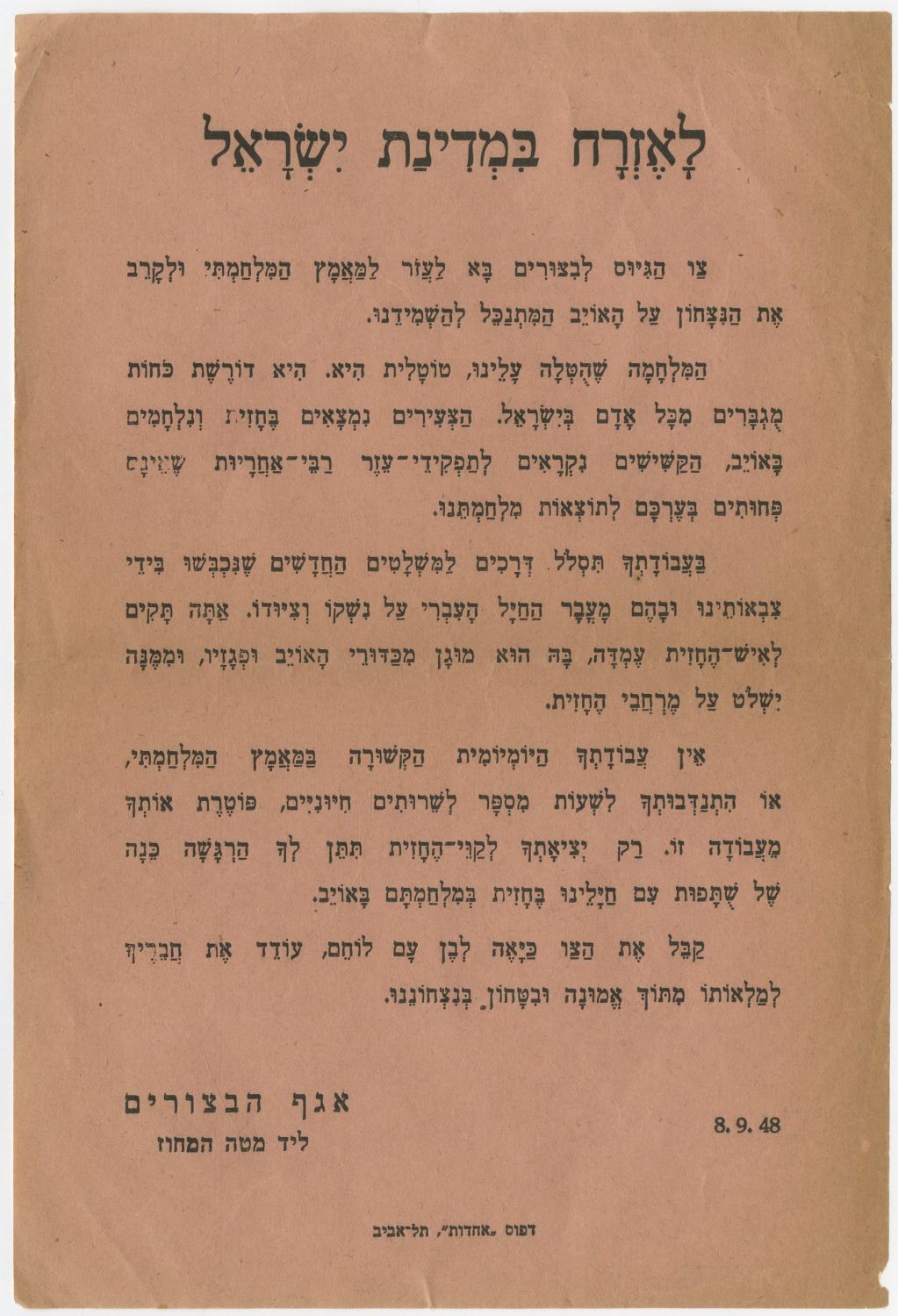
"To the Citizen in the State of Israel" - Proclamation with dotted letters calling to join auxiliary roles in the War of Independence. September 8, 1948: "The young are at the front and fighting the enemy, the elders are called to responsibilities of great importance in auxiliary roles no less valuable to the outcomes of our war".
The proclamation addresses mainly the elders not fighting at the front to take on auxiliary roles: "You will establish a position for the man at the front, protected from the enemy's bullets and shells, and from which he will control the spaces of the front... Only by going to the front lines will you feel a true sense of partnership with our forces at the front in their war against the enemy, accept the order as befits the son of a fighting people, encourage your friends to fulfill it with faith and confidence in our victory. The Fortifications Department near the District Headquarters".
23x16 cm. Very good condition.
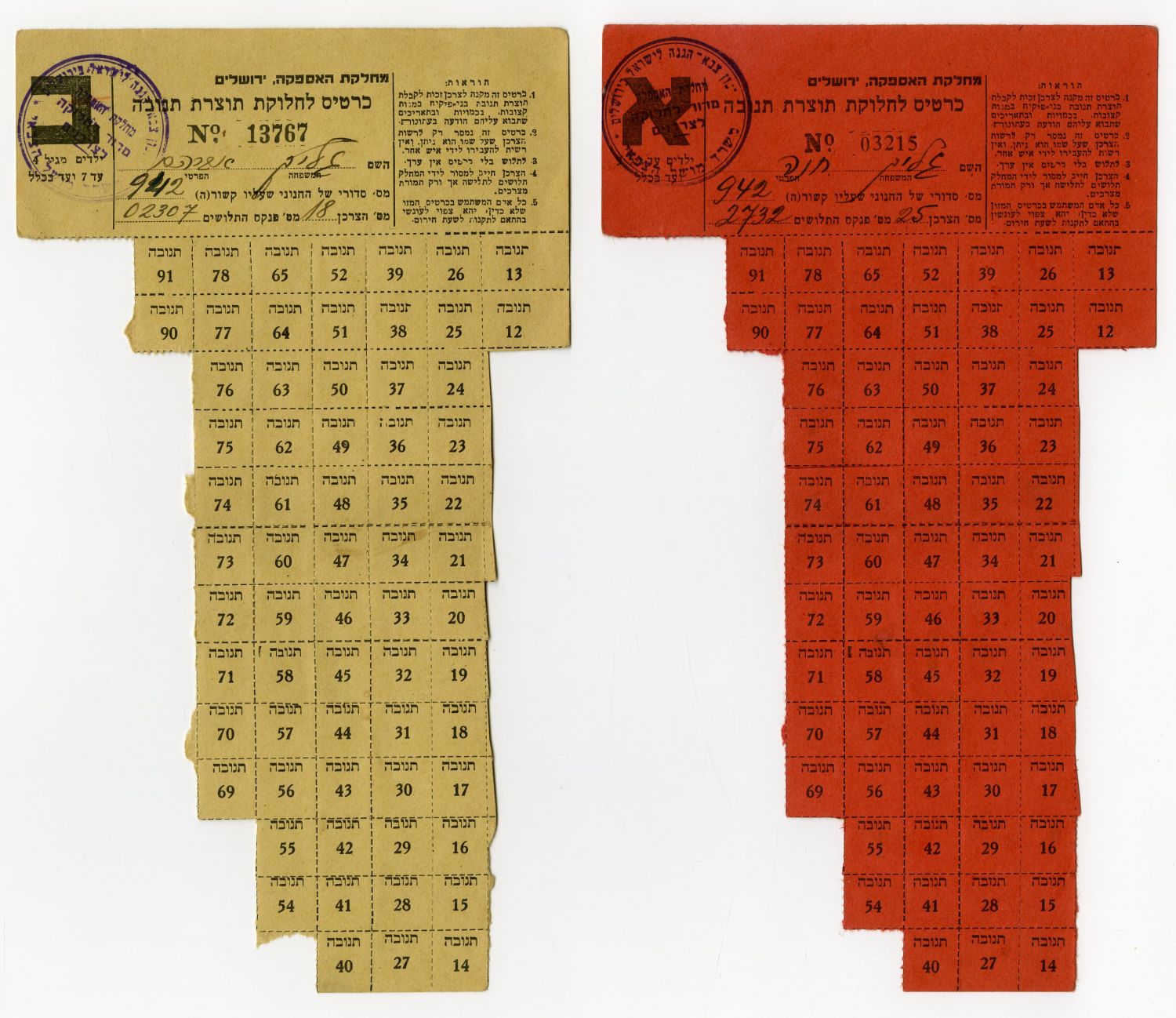
Two ration coupon tables for distributing Tnuva products during the siege of Jerusalem in the Israeli War of Independence from the "Jerusalem Supply Department". The coupons were intended for children ages 7 and up. Both tables have an ink stamp of the "Israel Defence Forces in Jerusalem Military Governor's Office." Jerusalem, 1948.
The coupons of Avraham Glick and Hana Glick. Partially used. In each table there remain 65 coupons (coupons for one family that were torn at the same time).
Very good condition.
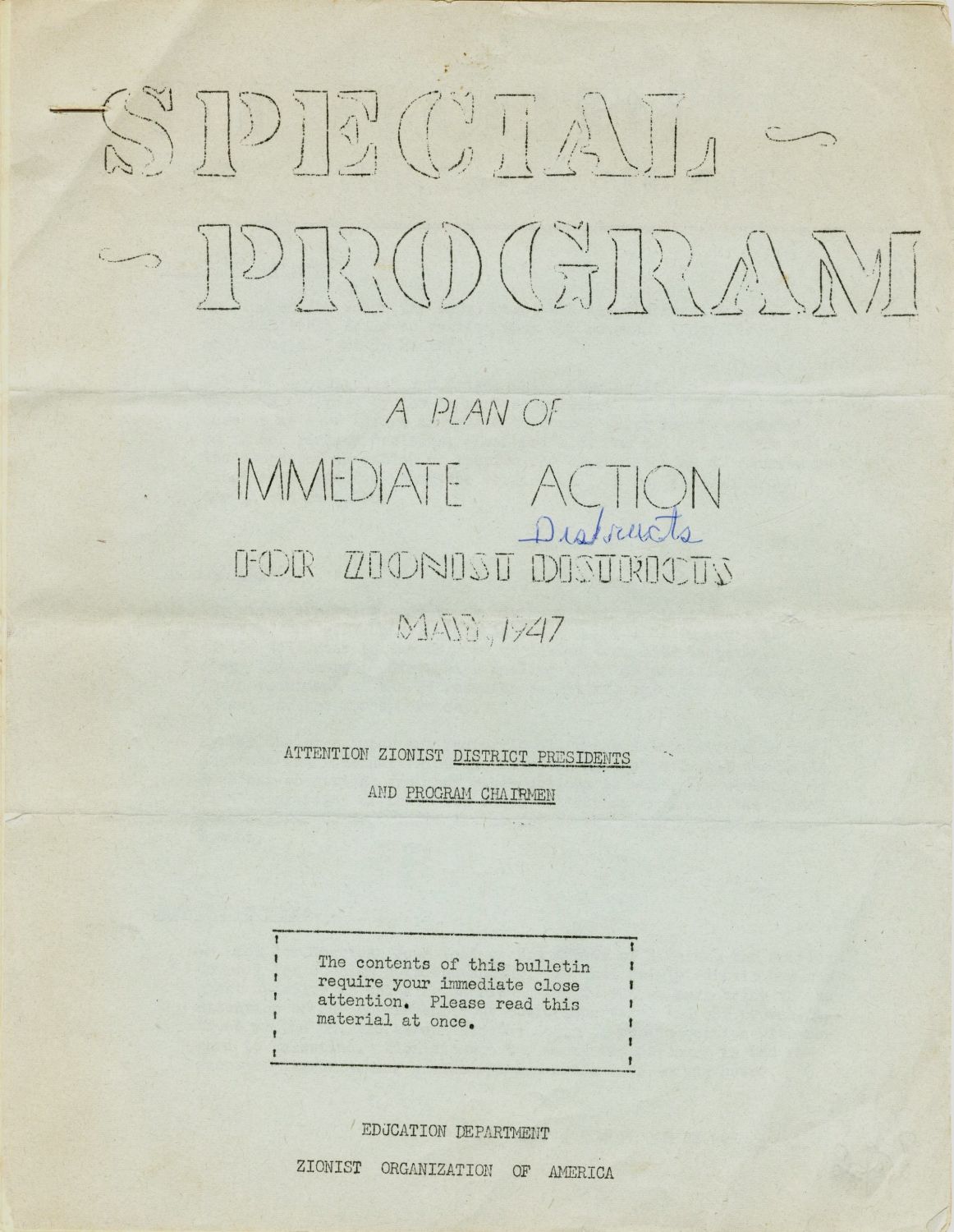
SPECIAL PROGRAM a plan of immediate action for zionist districts may, 1947. A rare booklet in stencil printing published by the Zionist Organization of America, which came out in the midst of the discussions at the United Nations in preparation for the partition plan decision. On the cover in a bold square is written: "The contents of this leaflet require immediate attention, please read this material immediately".
The booklet was sent to the branches and activists to explain the critical time "Our ultimate goal is to establish Eretz Israel as a Jewish state, there is no doubt about that". An informational booklet that aims to give activists the tools to get the UN Commission of Inquiry to reach a pro-Israel decision that is as good as possible for the Jews. The entire booklet is written in the spirit of "there is no time" and the necessity to act immediately due to the fate of the hour - and it details the methods of action - "in the press", "on the radio", "in diplomacy", and more - insert as many articles as possible in the local newspapers in favor of Israel - use the "Letter to the Editor" pages, call as many local radio stations as possible and convey the Zionist message on them, contact the representatives and senators in Washington, act in advocacy in the Democratic and Republican clubs, To appeal to non-Jewish organizations in explaining the necessity of establishing a Jewish state in the Land of Israel, and more.
Rare. It does not appear in the National Library.
[8] pages. Very good condition.
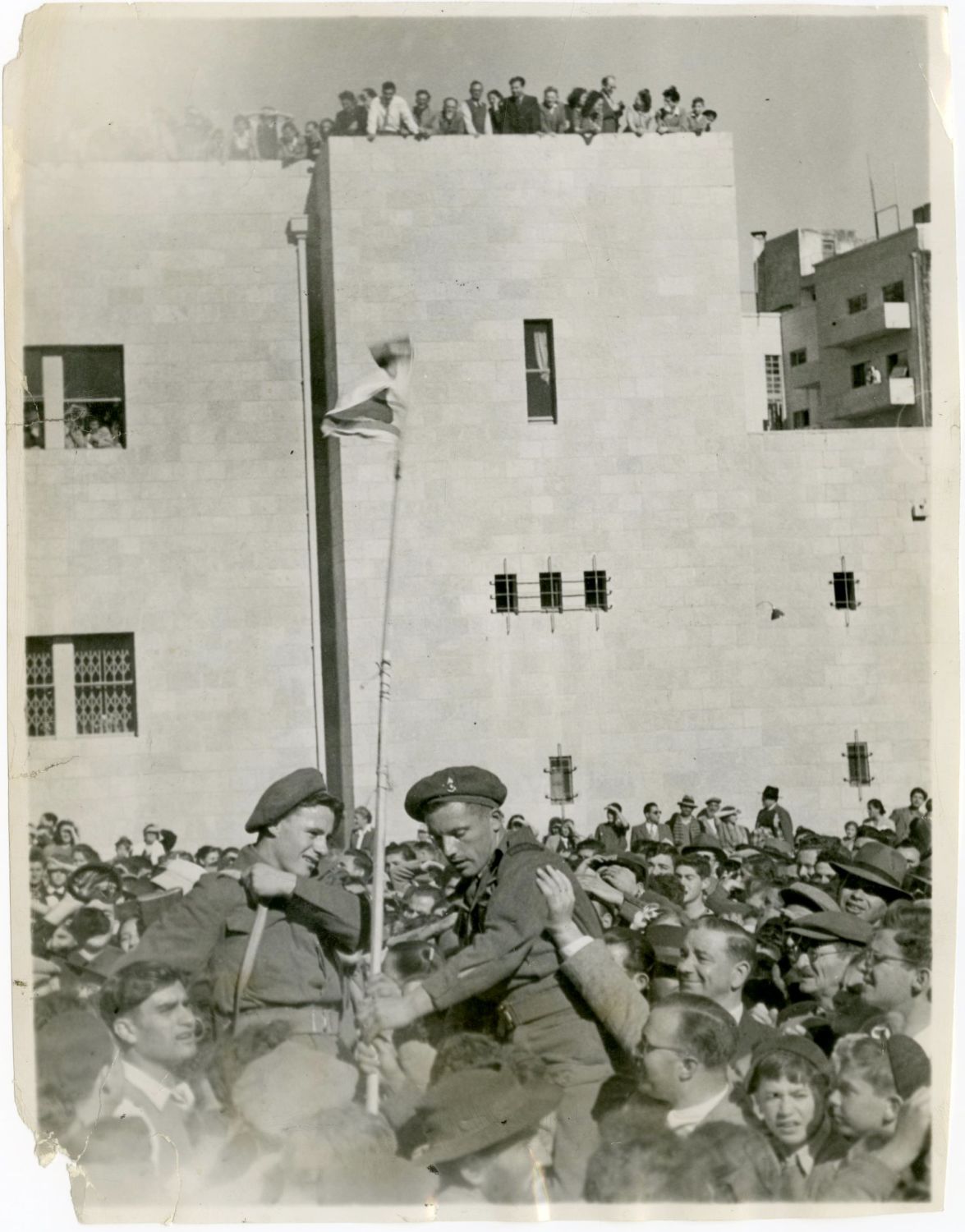
Press photo of British soldiers raising the flag of Israel in Jerusalem after the United Nations partition plan on November 4, 1947. According to the text written on the newspaper clipping in which the photograph was published (attached to the back of the photograph): "The UN decision aroused the anger of the Arabs, who began firing and looting throughout the Middle East." Rare.
24x19 cm. Open tear in the lower left corner. Good condition.
Created and Develop with 🤍By webe ©2024